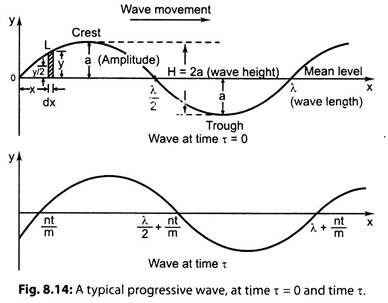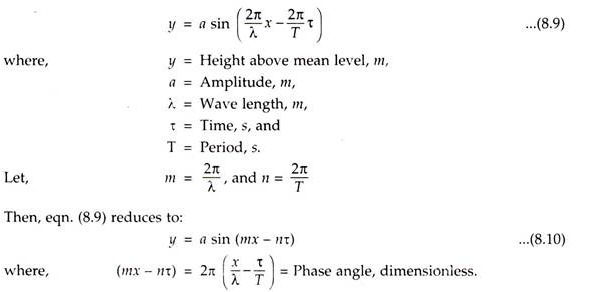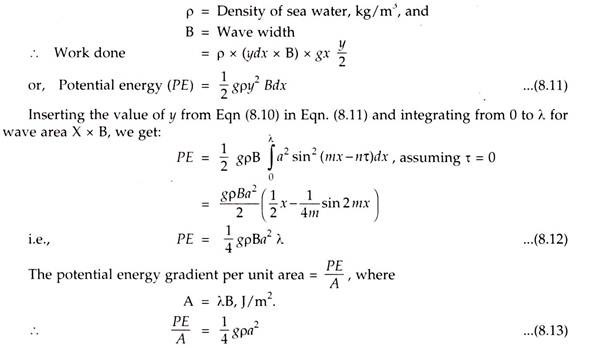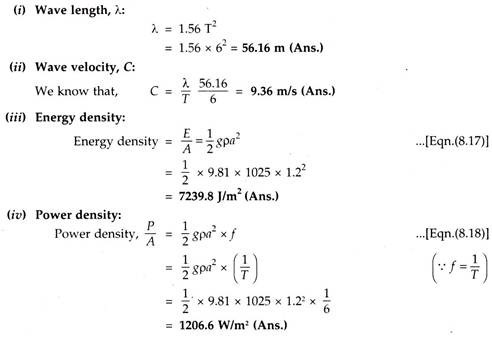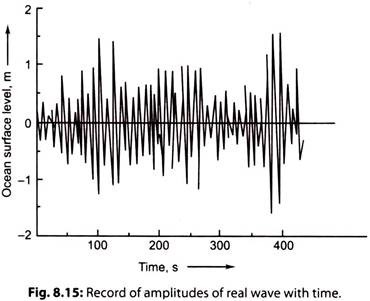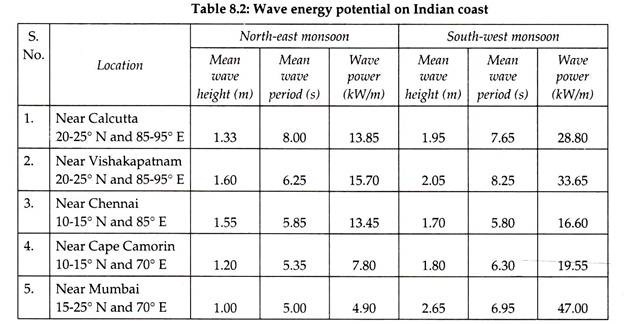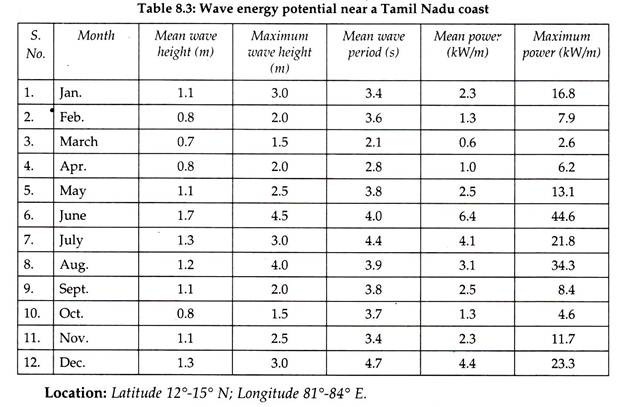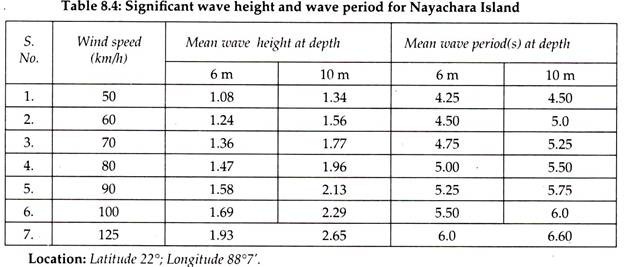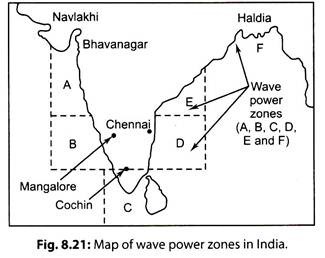Are you looking for an essay on ‘Wave Energy’? Find paragraphs, long and short essays on ‘Wave Energy’ especially written for school and college students.
Essay on Wave Energy
Essay Contents:
- Essay on the Introduction to Wave Energy
- Essay on the Factors Affecting Wave Energy
- Essay on the Parameters of Ocean Waves
- Essay on Energy and Power from Waves
- Essay on the Characteristics of Wave Energy
- Essay on the Potential of Wave Energy
- Essay on Wave Energy Conversion
- Essay on Wave Power Development
- Essay on the Environmental Impacts of Wave Power
- Essay on the Advantages and Disadvantages of Wave Energy
Essay # 1. Introduction to Wave Energy:
Wave energy comes from the interaction between the winds and surfaces of oceans. The energy available varies with the size and frequency of waves. It is estimated that about 50 kW of power is available for every metre width of true wave front.
Ocean wave energy is due to the periodic to-and-fro, up-and-down motion of water particles in the form of progressive waves. The period of ocean waves is the order of a few seconds. Ocean waves are superimposed on ocean water. Ocean water surface level varies with ocean tidal cycle.
Ocean waves possess potential energy (P.E.) and kinetic energy (K.E.). The ocean waves originate in different parts of the ocean surface due to the surface winds. The waves travel in the direction of the wind to the shore. The waves may be due to the local winds or the planetary winds. The height of the waves depends upon the wind velocities, depth of the ocean, contour of the shore etc.
The typical ranges of ocean waves are:
(i) Wind height = 2 x amplitude = 0.2 m to 4 m
(ii) Wave period = 4 s to 12 s.
Very dangerous and destructive waves occur during storms and gusts. They may reach heights of 10 m and may topple ships and damage the ocean energy plants.
Wave energy when active is very concentrated therefore wave energy conversion into useful energy can be carried out at high power densities. A large variety of devices (e.g. hydraulic accumulator wave machine; high-level reservoir machine; Dolphin-type wave-power machine; Dam-Atoll wave machine) have been developed for harnessing of energy but these are complicated and fragile in face of gigantic power of ocean storms.
Essay # 2. Factors Affecting Wave Energy:
Wave energy is affected by the following three major factors:
1. Wind Speed:
With the increase in wind speed, there is an increase in wind energy.
i. The amplitude of the waves depends on wind speed.
ii. During storms and gusts, big ocean waves occur, which prove highly detrimental even to ships.
2. Effective Pitch Value:
It is the uninterrupted distance on the ocean over which the wind can below before reaching the point of reference. The larger the distance, the higher the wave energy. This distance may vary from 5 km to 45 km.
3. Depth of Ocean Water:
The greater the depth of ocean water the higher the wave velocity. Very large energy fluxes are available in deep ocean waves.
Essay # 3. Parameters of Ocean Waves:
A progressive wave (travelling wave) is a wave whose crest line moves in the direction of propagation of wave.
The important parameters and their notations are:
Essay # 4. Energy and Power from Waves:
Fig. 8.14 shows a two-dimensional progressive wave, represented by the sinusoidal simple harmonic wave shown at time, x = 0, and at time x. Although the sea waves are highly irregular yet, such a wave is assumed to be of sinusoidal harmonic wave shape for the purpose of mathematical analysis. The wave is moving in the direction of x-axis.
Consider a point L (x, y) on the wave surface with an element of thickness dx along the x-axis with a coordinate y on the y-axis.
This sine wave may be expressed by the following relation:
Potential Energy (PE):
The potential energy depends on the elevation of water above mean level (i.e., y = 0).
In order to calculate the potential energy of elevated water, let us find out the work to be done in raising the quantity of water to the elevated height as given below:
Work done = Force x distance = mgh joules
where, m = Mass of water element dx
= p x ydx x B, kg
h = y/2 (i.e., mean height), m,
Kinetic Energy (ke):
When the amplitude a of the wave is small compared to its wave length, then the PE and KE are equal.
Total Energy (E):
Wave Power (P):
Empirical Formulae on Wave Energy:
1. Scripps Formula:
The scripps formula proposed by the Scripps Institution of Oceanography in La Jalla California gives a relationship between wave height and wind velocity as:
H = 0.085 U2 …(8.19)
where, H = The wave height, m, and
U = The wind speed in knots (1 knot = 1.4 km/h)
2. Zinder Zee Formula:
Zinder Zee formula is given by:
K = 6.08 x 10-3 (constant),
F = Fetch i.e. unobstructed largest dimension of the lake, m,
V = Wind speed, km/h,
D = Average water depth, m, and
a = Angle between the wind direction and the fetch.
Example:
Ocean waves on an Indian coast had an amplitude of 1.2 m with a period of 6 s measured at the surface water 110 m deep.
Taking water density as 1025 kg/m3, calculate the following:
(i) The wavelength,
(ii) The wave velocity,
(iii) The energy density, and
(iv) The power density of the wave.
Solution:
Given: a – 1.2 m; T – 6 s; p = 1025 kg/m3
Essay # 5. Characteristics of Wave Energy:
In real oceans, final waves are made up by the combination of component waves; each component wave has different amplitude, wavelength, direction, period, etc. depending upon wind and ocean bed along the routes.
i. The waves generated in deep ocean by distant storms are very high and dangerous, called swells. These have longer wavelengths.
ii. The waves in shallow waters and by local winds are not high and have shorter wavelengths.
Essay # 6. Potential of Wave Energy:
Collection of Wave Data:
The wave data is collected (by Institutes of Oceanography) by measuring the parameters of real ocean waves over a period of 1 to 3 years at selected locations on shore and high oceans.
i. The measuring instruments (e.g. accelerometer, integrator, recorder etc.) are mounted on a ship or a buoy. The vertical displacement and vertical acceleration of the ship or the buoy are measured and recorded.
ii. The data is scanned at an internal of every 3 hours over a period of about 20 minutes with duration of 0.5 second per measurement.
iii. The data is telemetered to the observatory on the shore by means of radio communication channels. The data is recorded and analysed.
From the analysis of wave data the following characteristics are determined:
1. The significant height of the wave.
2. The period of significant wave.
3. The energy period.
4. The energy density.
5. The power density.
6. The power per unit width.
From these characteristics of ocean waves, a wave power plant in planned.
These days the computer-based methods are used for the analysis of wave data. Such analysis of wave data helps to estimate the potential of maximum, minimum and mean power at desired locations.
Wave Energy Potential of Indian Coast:
India has ample wave energy potential. Some data relating to ocean wave energy, for different locations obtained through measurements, are given in the tables 8.2, 8.3 and 8.4 respectively.
Essay # 7. Wave Energy Conversion:
The wave energy is in the form of motion of water particles.
The potential energy and kinetic energy in water are converted to mechanical energy in the ‘wave machine’ (wave energy converter) in the following two ways:
1. Wave machine drives gears and electrical generator.
2. Wave machine drives air compressor or hydraulic pump to store energy in tanks, drive another machine for energy conversion.
The former method/route is preferred as the energy can be transmitted to the shore.
Essay # 8. Wave Power Development:
i. The history of wave machines begins with the first patent filed in parts in 1799 by Girard. The proposed plant envisaged a floating moored ship, connected to a mechanism and a pump mounted on the shore by means of a long rod. The ship oscillated vertically and the horizontal movement was prevented by mooring. The oscillating shaft motion was converted to rotary motion by mechanism at the shore; the mechanism drove the pumps.
ii. During 1890s the wave phenomenon was analysed by physicists and oceanographers.
iii. During 1910 to 1950, small prototype wave machines of various types were designed on experimental basis in USA, UK, Japan, Canada.
iv. During 1959, a 5 MW pumped storage system was built. It was abandoned in 1965 as the oil prices were low. The scheme was reviewed during 1976 and a 20 MW scheme was proposed.
v. After 1973 oil price rise, several prototype plants of 100 to 500 kW were developed. Wave power engines of small rating (<500 kW) are commercially marketed by Japan for installing on lighthouses, buoys and remote Islands etc.
Large pumped storage schemes operated by hydro-turbine pumps by wave energy were commercially successful in Mauritius (1976) for large base load power plant. Such schemes require suitable geographical contours for installing hydro-electric plants and reservoirs.
Wave Power Development in India:
The National Institute of Oceanography Goa has divided the Indian coastline into six zones, namely A, B, C, D, E, and F (Fig. 8.21), to expedite and identify high wave energy areas suitable for development of power.
The variation (estimated power in kW/m) in wave regime in different zones during different months is given in the table 8.5.
On the estimates of the distribution of wave energy (kW/m) of sea frontage, the potential is seen to vary from 39 kW on the West coast to 15 kW on the East coast. On the basis of an average estimated wave power potential of 15 kW/m and total coastline of about 6000 m the total power potential is of the order of 90,000 MW, which is an enormous source of renewable energy which can be harnessed commercially.
Essay # 9. Environmental Impacts of Wave Power:
The “Wave power” is essentially non-polluting. No appreciable environmental effects are for seen from island floating wave power devices.
i. Onshore wave energy installations may change visual landscape and degrade scenic ocean front views. It may also cause disturbance to marine life including changes in distribution and types of life near the shore.
ii. There is possible threat to navigation from collision due to low profile floating wave devices. It would usually be both possible and necessary to avoid hazards to, or from, marine traffic by judicious planning and by the provision of navigation aids. “Tidal energy” is a renewable source of energy, which does not result in emission of gases responsible for global warming or acid rain associated with use of fossil fuels.
iii. Changing tidal flow by damming a bay or estuary could, however, result in negative impacts on aquatic and shoreline ecosystem, as well as navigation and recreation.
Studies have shown that the environment impact at each site is different, and depends amply upon local geography.
Essay # 10. Advantages and Disadvantages of Wave Energy:
Following are the advantages and disadvantages of wave energy:
Advantages of Wave Energy:
1. It is relatively pollution free.
2. It is a free and renewable energy source.
3. After removal of power, the waves are in placed state.
4. Wave-power devices do not require large land masses.
5. Whenever there is a large wave activity, a string of devices have to be used. The system not only produces electricity but also protects coast lines from the destructive action of large waves, minimises erosion and help create artificial harbour.
Disadvantages of Wave Energy:
1. Lack of dependability.
2. Relative scarcity of accessible sites of large wave activity.
3. The construction of conversion devices is relatively complicated.
4. The devices have to withstand enormous power of stormy seas.
5. There are unfavourable economic factors such as large capital investment and costs of repair, replacement and maintenance.
Problems Associated with Wave Energy Collection:
The collection of wave energy entails the following problems:
1. The variation of frequency and amplitude makes it an unsteady source.
2. Devices, installed to collect and to transfer wave energy from far off oceans, will have to withstand adverse weather conditions.
Until now no major development programme for taming wave energy has been carried but successfully by any country. Small devices are available, however, and are in limited use as power supplies for buoys and navigational aids. From the engineering development point of view, wave energy development is not nearly as far long as wind and tidal energy.



